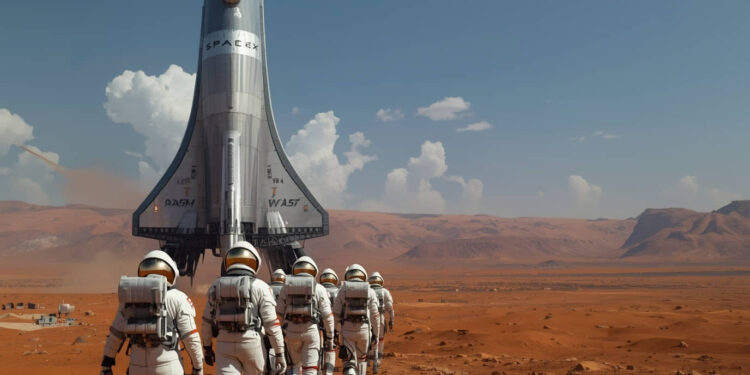The idea of humans going to Mars has been getting people excited for some time now. One of the companies leading the race to make interplanetary travel a reality is SpaceX, whose Starship spacecraft is on that top list. Intended for use on long-duration deep-space missions as well as ultra-rapid reusability, Starship is the most powerful rocket we have ever built, and will open new frontiers for space exploration just as the Saturn V did with Apollo half a century ago by massively lowering the cost of launches to orbit while increasing reliability and reusability. If you want to make life multiplanetary — which means humans living on Mars or other planets in our solar system — it’s all about making things affordable, explained Lars Blackmore, senior launch site integration engineer at SpaceX.
Revolutionary Design Principles
Starship is a two-stage system: the Super Heavy booster and Starship upper stage. At nearly 70 meters tall, the first stage of Super Heavy will use 33 Raptor engines running on a combination of liquid flaming methane and liquid oxygen. Above that lies the 50-meter-tall Starship spacecraft, powered by six sea-level and three vacuum-optimized Raptor engines. It is the only full stainless-steel structure capable of handling reentry heat that is low-cost to manufacture.
At the heart of Starship’s game-changing properties is its full reusability. After the liftoff, Super Heavy module disconnects and returns to the launch pad in a powered descent that the vehicle will use grid fins for and thrust vector control to pinpoint its landing. At the same time, Starship enters orbit, deploys a payload and eventually does its own deorbit burn to perform a controlled propulsive descent toward Earth or another target body.
Unprecedented Payload Capacity
One of the most revolutionary aspects of Starship is its payload capacity. A single Starship launch, he said, would be capable of taking more than 100 metric tons to low Earth orbit — over twice the payload of any rocket currently flying. For Mars missions, that will translate to carrying large habitats, life-support systems, scientific instruments and propulsion modules on orders of magnitude fewer launchers. The cargo might be pressurized modules, power plants, solar arrays and even in situ resource utilization (ISRU) facilities before the crew arrives on Mars.
Also, Thanks to the massive (over 1,000 m³) internal volume of Starship, it could bring whole modular habitats or several vehicles on the same trip. This simplifies Mars assembly and speed up the construction of the base, so a more unified series of baby steps turns into a continuous colonization effort.
Lowering the Cost of Access
The most fundamental obstacle in colonizing Mars is the astronomical cost of transferring mass to orbit. Conventional disposable rockets now cost more than $2,000 per kilogram. SpaceX hopes to lower that to as little as $10 per kilogram by reusing Starship. Refurbish and refly both stages hundreds of times, however, and the per-launch cost plunges — large-scale logistics becomes affordable.
This discounted price allows drone service providers to make supply runs often, to regularly replace old hardware and to slowly build up infrastructure. Routine flights of Starships to and from Mars, at regular intervals like a commercial airline route, would help maintain a growing settlement by bringing necessary material and personnel.
In-Situ Resource Utilization
Dragging all of the propellant for a there-and-back trip with you from Earth is not mass-effective. Instead SpaceX will set up fuel factories on the Martian surface based on the Sabatier reaction, which transforms Martian carbon dioxide — and hydrogen brought from earth — into methane and oxygen. These methane-oxygen propellants would refuel Starship in orbit around Mars or on Mars’s surface, which could allow return flights without the need for any Earth-launched propellant.
Starship can deliver ISRU plants, process equipment, energy sources and storage tanks in bulk. Accumulated over multiple missions, a fleet of methane-production units could amass hundreds of metric tons of propellant. This ISRU-centric architecture not only reduces mission mass but also enable self-sufficient colonies.
Surface Operations and Habitats
Once landed on Mars, the ample room in Starship’s cabin and the aft cargo area again make for a short interval between arrival and being able to load crew cabins and rovers. Inflatable or ready-made modules, science labs, greenhouses and communication systems could be parked on the lunar surface within days instead of weeks. So that even early settlers will have power during the dark shinny days of springA week without daylight, gives a lot of wear on equipment If Nothing else Starship Have built in solar panels and they come with those Nuclear battery modules to keep things sputtering along even then.
The design also allows replenishment of water, fuel and life support supplies. Equipped with water-extraction systems that draw ice from below Mars’ surface, the Starship could deliver crews along with gear to pump, purify and store water supplies. Finally, with some time these operations mature into an efficient supply chain that processes the raw Martian resources and turns them into breathable air, drinkable water, and construction material.
Rapid Reuse and Fleet Expansion
SpaceX has its eyes set on a fleet of 1,000 or more Starships traveling between Earth, Mars and beyond. Reuse has driven down turnaround time; after it is refurbished, a Starship can fly again in days. The fact that this vehicle is reusable, and the capability to perform refueling operations on Earth orbit also serves to lower costs and boost launch rate.
Once a Mars colony gets started, a continual flow of Starship flights would provide scaleable logistics. Crew changes and transport of goods, as well as emergency evacuation, are routine. Similarly, a large fleet also promotes resilience (if one ship experiences a failure others in the line support supply continuity).
Timeline and Challenges
SpaceX has already flown several suborbital and orbital test flights of the vehicle, including controlled landings of smaller Starship prototypes. The ultimate goal for Starship is an even larger vehicle, to get peopletomars in the early 2030s. Crewed missions would then be possible by the early 2030s subject to regulatory approvals and system development.
However, significant challenges remain. The talent needed for thermal protection during atmospheric entry both on Earth and Mars, then, requires heavy-duty testing of heat-shield tiles. Life-support systems need to work for months on end. Engineering and medical studies on crewed missions should also necessitate radiation protection and psychological health care. What’s more, planetary protection procedures have to keep Mars free of Earth germs.
The Vision of a Multiplanetary Species
Beyond the engineering marvels, Starship represents a philosophical shift: the evolution of humanity from a single-planet species to one that spans multiple worlds. Mars colonies are redundant against Earthbound existential risks like asteroid strikes or planetwide disease. The discovery of how to live and thrive on Mars likewise sparks technological advances(e.g., in renewable energy, agriculture, closed-loop life-support) with applications back home.
Elon Musk’s company SpaceX has unveiled its spacecraft that it hopes will carry humans to Mars within a decade.Credit goes to SpaceX, it seems increasingly on target: the establishment of cities on Mars with 1 million or more residents; ordering up gravitational fields and “walking blobs” for life in outer space as easily as we buy appliances. And all coming about through something like the first steamship routes across the Atlantic between New York and London. By offering inexpensive and regular passage, Starship takes Mars from awe inspiring idea to achievable goal.
Conclusion
SpaceX’s Starship isn’t just a fresh new take on a rocket but an entire spacecraft designed to ferry humans and their stuff around not only orbit, but to the moon, Mars or any other destination in the solar system. With it’s incredible ability to lift payload, rapid re-usability and ISRU potential, Starship solves for the problems of logistics, cost and sustainability_. As flight tests progress and infrastructure builds on Mars, the dream of a self-sustaining colony approaches. And in this great undertaking, Starship becomes the keystone of Mars settlement — our generation’s bridge to an exciting future for humanity exploration, creativity, and growth.


